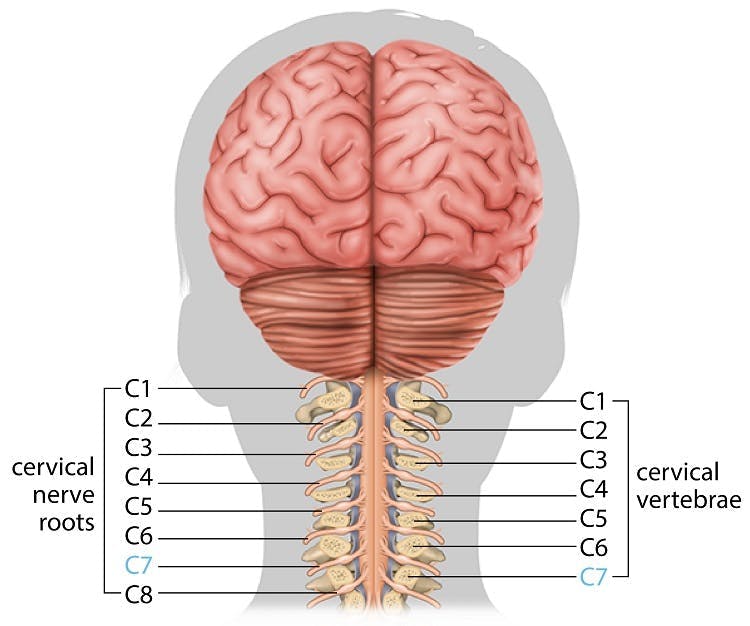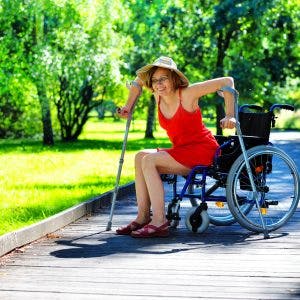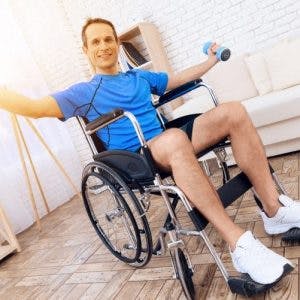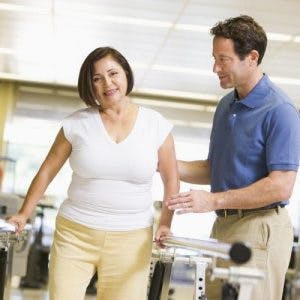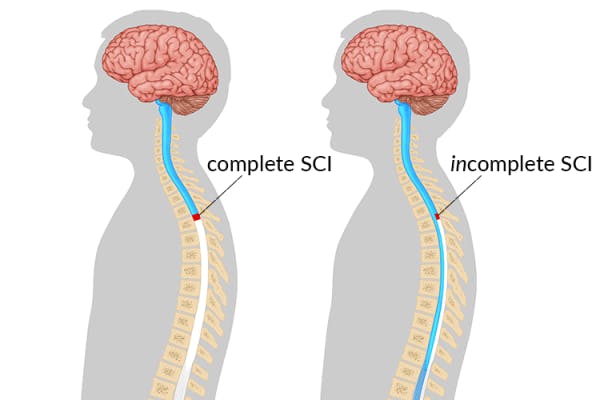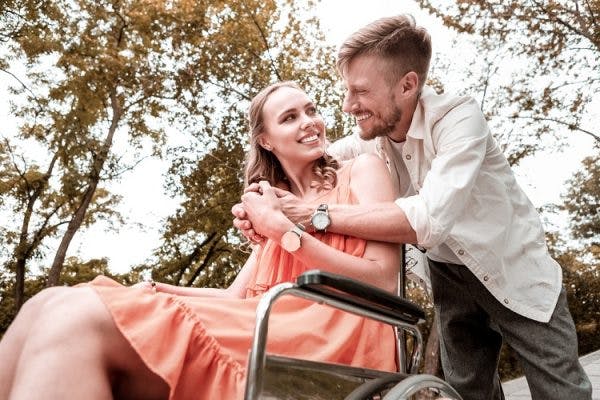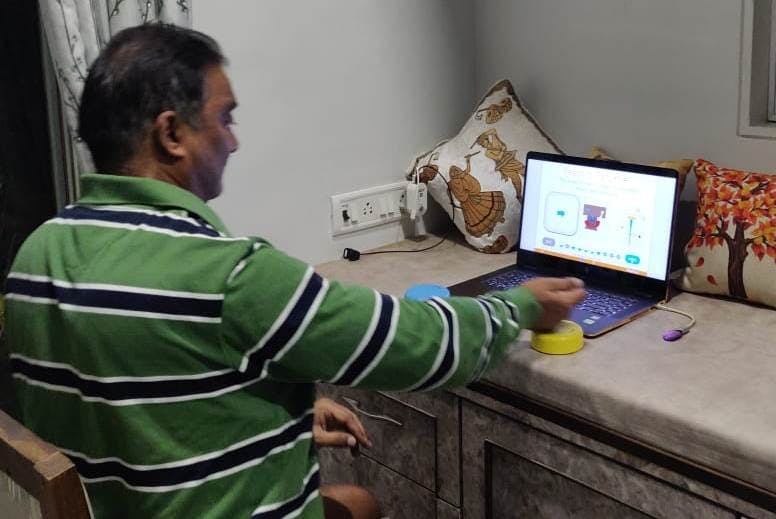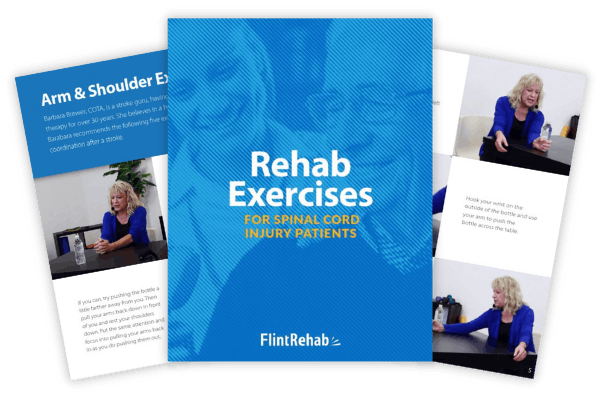Cervical spinal cord injuries are often the most severe and, because they occur high in the cervical (neck) region of the spinal cord, can result in quadriplegia or paralysis of all four limbs. However, upper body function may be spared in a C7 spinal cord injury because this segment is further down the cervical region of the spinal cord. The lower the level of injury, the higher the chances of retaining movement and sensation.
This article will discuss what occurs in the aftermath of a C7 spinal cord injury and how to boost the recovery process. Use the links below to jump straight to any section:
- Effects
- What to Expect
- Incomplete vs. Complete C7 SCI
- How to Regain Movement
- Complications
- Recovery Process
The Potential Effects of a C7 Spinal Cord Injury
Injury to the cervical nerves of the spinal cord often leads to the most severe damage and loss of function because they are closer to the brain. Survivors may experience different outcomes depending on the severity and level of injury. The level of injury refers to the lowest region of the spinal cord where sensation and motor function exist.
Individuals with a C7 spinal cord injury in particular may have limited or absent sensation (feeling) or movement below the shoulders and/or neck. This can make it difficult to move or feel anything in the lower body, trunk, and sometimes even in the hands and fingers.
Spinal cord nerves innervate, or connect to, different parts of the body and can control both sensation and movement. The different areas these nerves innervate are called dermatomes and myotomes, which can be “tested” for function by a doctor or therapist.
Dermatomes are regions of the skin supplied by sensory neurons from a single spinal nerve. When sensation is not felt at a certain dermatome, it can indicate that sensory information related to that spinal nerve cannot reach the brain. The C7 dermatome can be tested with a pinprick or light touch at the middle finger.
Spinal nerves also innervate different groups of muscles, called myotomes. The muscles innervated by the C7 spinal cord root include the triceps, wrist flexors, and finger extensors. These are essential for certain functions such as straightening the elbows and bending the wrists.
What to Expect After a C7 Spinal Cord Injury
Generally speaking, the lower the level of injury, the higher the possibility of sensation and mobility existing in different areas of the body. Higher-level spinal cord injuries may require regular caregiver assistance. However, survivors with a C7 spinal cord injury often have upper body control and can perform many activities independently.
Studies have shown that individuals with a C7 spinal cord injury can have many upper body functions remain intact. This can include sensation in the head, neck, clavicle, shoulders, outer arms, thumbs, and fingers.
Other functions may include full control of the head, neck, shoulders, elbows, and wrists. Individuals with an injury at the C7 level also have control of actions such as breathing, speaking, and chewing independently, and can even have trunk or postural control.
Because a C7 spinal cord injury allows for use of the triceps and wrist extensors, survivors may also be able to transfer (move from one surface to another) and use a manual wheelchair on their own. However, it’s important to avoid overworking or injuring the arms and shoulders, especially when using a manual wheelchair.
With the help of adaptive equipment such as hand controls, some individuals with a C7 spinal cord injury can even drive a car independently. It can help to talk with your occupational and/or physical therapist to discuss what adaptive equipment or modifications will be best for your specific needs.
Incomplete vs. Complete C7 Spinal Cord Injury
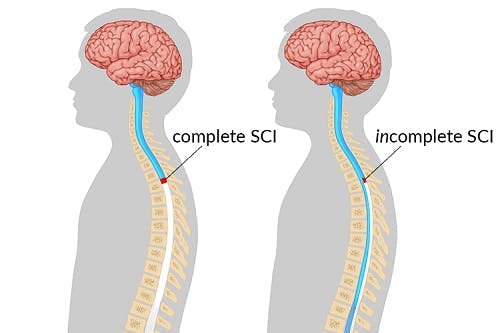
The severity of a C7 spinal cord injury depends on whether the injury was complete or incomplete. A complete spinal cord injury means the spinal cord was fully severed, and there is no movement or sensation below the level of injury. In an incomplete spinal cord injury the spinal cord is only partially severed, with some spared neural pathways for movement and sensation remaining below the level of injury.
Neural pathways may become damaged or destroyed after a C7 spinal cord injury, making it difficult for the brain to communicate with the body via the spinal cord. Fortunately, spared neural pathways can be strengthened and new ones created with the help of neuroplasticity, the nervous system’s ability to rewire itself.
Neuroplasticity helps restore communication between the brain, spinal cord, and muscles to eventually improve function. While a complete injury indicates no movement or sensation below the level of injury, individuals with incomplete injuries have higher chances of regaining function through neuroplasticity.
How to Regain Movement After Spinal Cord Injury
To activate neuroplasticity, the nervous system must be stimulated through high repetition of exercises, or massed practice. The more a function is practiced, the stronger its neural pathways will become. This does not mean, however, that individuals with a complete injury cannot make improvements in strength and function—in fact, just the opposite!
Your therapist can provide you with the therapeutic exercises that are safe and optimal for you. This can include a variety of active exercises and passive range of motion exercises. Passive exercise involves using the assistance of your non-affected limbs or a therapist to help move your affected muscles through their full range of motion.
Performing passive exercises with the help of your therapist or trained caregiver is a great way to promote movement in the affected muscles and stimulate neuroplasticity. This is beneficial to help the nervous system heal, improve blood circulation in the body, and prevent your joints from stiffening.
Every spinal cord injury is different and the rehabilitation process may look different for everyone. Depending on the severity, some may encounter positive results more swiftly than others. To boost your motivation during recovery, it helps to focus on what you can do rather than what you cannot just yet.
Over time, with consistent practice, you can increase the chances of recovery from a C7 spinal cord injury. It is essential to prioritize movement during the recovery journey as this helps lower the risk of further injury or other complications of a spinal cord injury.
Potential Complications of a C7 Spinal Cord Injury
A C7 spinal cord injury results in loss of movement and sensation, which can affect other functions in the body. The more severe an injury, the higher the risk of developing complications such as pressure sores.
Pressure sores typically develop in bony areas such as the elbows, sit bones, tailbone, hip bones, heels, ankles, and knees. Remaining in the same position for prolonged periods of time can cause excess pressure to build up, especially at these bony areas.
This increased pressure can restrict blood flow and cause the skin to break down. If left untreated, this skin breakdown can worsen and even cause damage to underlying bones or joints. Pressure sores can also increase the risk of developing other complications like infection.
To prevent pressure sores from developing, be sure to change positions frequently, such as every two hours when in bed, and every 30 minutes when sitting up in your wheelchair. It’s also important to inspect your skin daily. In the hospital, your doctor or therapist can provide proper care tips to help avoid this complication.
Additionally, immobility can slow down blood circulation throughout the body, decrease heart rate, and even interfere with your metabolism. This can cause blood to pool in the arms and legs, reducing blood supply returned to the heart. Insufficient blood supply can cause dysfunction in your major organs. To lower the risk of complications, it’s important to promote frequent movement of the affected muscles.
Other potential complications of a C7 spinal cord injury can include:
- Bladder and bowel dysfunction: Loss of sensation and motor control can result in the inability to control bladder and bowel reflexes and muscle contractions, making you prone to accidents. To prevent this from happening, a catheter may be necessary to remove urine. Suppositories, medications, and/or other techniques may also help control bowel movements. It is important to establish a good bowel program with the help of your rehab team.
- Reduced bone and muscle mass: Paralysis after a C7 spinal cord injury can make it difficult to move your limbs. Because muscles and bones are being used less, muscle atrophy (shrinking of the muscles) and decreased bone density can occur.
- Disrupted autonomic nervous system functions: The autonomic nervous system (ANS) is responsible for the regulation of involuntary body functions such as temperature, heart rate, blood pressure, and digestion. These functions can be affected by loss of movement and sensation after a C7 spinal cord injury, causing complications such as autonomic dysreflexia.
Survivors may also experience pain and/or spasticity (involuntary muscle contractions) below the level of injury. Although these symptoms may be challenging to overcome, they can sometimes be positive signs of recovery from spinal cord injury because this indicates that there may be connections between your brain, spinal cord, and muscles remaining.
C7 Spinal Cord Injury Recovery Process
To maximize your chances of recovering from a C7 spinal cord injury it’s important to prioritize movement and establish a proper rehabilitation regimen. Rehabilitation can include a combination of physical and occupational therapy exercises that focus on improving mobility, strength, and function after a spinal cord injury.
Physical therapy particularly focuses on improving your gross motor skills involving large muscle groups such as the arms, legs, and torso. This can involve exercises focusing on strength, range of motion, and coordination.
Occupational therapy focuses on improving your fine motor skills to help you maximize your independence and perform daily activities on your own. This can include activities such as brushing your teeth and getting dressed. Physical and occupational therapists can also help you practice transfers (like moving from your bed to your wheelchair) and suggest home modifications.
Therapists may also recommend using adaptive devices such as a universal cuff to help you eat, brush your teeth, and write independently. While adaptive tools can be helpful for completing daily tasks, it’s important to simultaneously practice therapeutic exercises.
For instance, if you notice your hand function improving, challenge yourself to perform tasks without adaptive tools. This can help you achieve higher repetition of exercises and increase strength and coordination.
Consistent practice of therapeutic exercises helps stimulate the nervous system and activate neuroplasticity, which is essential for C7 spinal cord injury recovery.
Understanding a C7 Spinal Cord Injury
Although a C7 spinal cord injury can impair movement and sensation below the level of injury, upper body functions usually remain intact. The severity depends on whether the injury was complete or incomplete. The more neural pathways remaining after an injury, the higher the chances of stimulating neuroplasticity and regaining function.
While a C7 spinal cord injury can make it challenging to perform daily activities, it’s important to find ways to stay motivated and achieve high repetition of therapeutic exercises. The more a skill is practiced, the more the nervous system will strengthen the neural pathways necessary for that function.
We hope this article helped you understand the effects of a C7 spinal cord injury and how to boost the recovery process.

